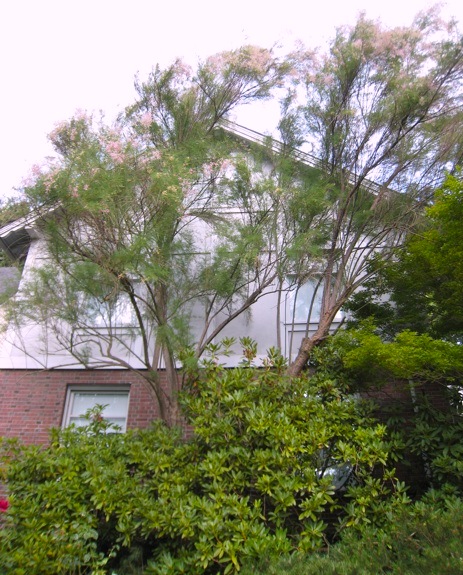| Defined by Linnæus in 1753, the genus Tamarix consists of about 50 species of fine-textured Old World large shrubs or small trees, called tamarisks or salt cedars. Tamarix is an ancient Latin name, maybe after a river, or it may be an African or Hebrew word --there is much conjecture but no certainty. |
| This genus features delicate foliage recalling that of Asparagus, and lovely pink flowers. Tamarisks are tough and tolerant of adverse conditions such as along sea coasts, in salty soil, and in deserts. Some species have become serious weeds in certain locales of the western United States. But in Seattle the genus is not at all weedy. |
Gross confusion exists in naming and identification. The following account lists only the two species that I believe are cultivated in Seattle, and although 5 cultivars are also included I do not know how many of them are present here. Close examination of the minute scale-like leaves and tiny flowers is needed for precise naming. Any tamarisk can be trained to tree form, but left alone is usually a wide bush. The bark is often handsome red-brown, shreddy, cedar-like. Some clones are most ornamental and floriferous if kept as heavily pruned shrubs. In cold northern regions the climate keeps them shrubby.
|
| T. chinensis Lour. 1790 |
| = T. pentanda hort., non Pall. 1788 |
| =? T. ramosissima Ledeb. 1829 |
Summer-flowering tamarisk. Salt cedar. Salt shrub. Rose tamarisk. Flowering cypress. From China and temperate E Asia. Introduced to cultivation in 1827. Whether T. ramosissima should be considered a synonym of T. chinensis (my vote) or a closely related species is disputed; a recent study found the two genetically indistinguishable. Offered by few nurseries, except in its cultivars (below). Foliage blue-green. Flowers showy rose-pink, from June through September. The largest I have found recorded from elsewhere is 45 feet tall x 14 feet 2 inches trunk circumference x 50 feet wide in Albuquerque, NM (1999). The tallest of the few treelike specimens I know in Seattle is 27 feet, at 1230 Federal Avenue E. (Even taller when cut down in February 2010)
|
| T. chinensis 'Cheyenne Red' |
| = T. pentanda hort., non Pall. 1788 |
Introduced by or before 1980 in the Midwest. Apparently out of commerce. Flowers darker than typical. T. chinensis 'Rubra' is similar.
|
| T. chinensis 'Pink Cascade' PP 1275 (1954) |
| = T. Odessana 'Pink Cascade' |
Raised by Jackman nursery of Surrey, England. Gulf Stream nursery of Wachapreague, VA, imported this and patented it. Offered by Wayside nursery in 1955. Common. A shrub of great vigor. Flowers slightly richer pink than those of T. chinensis 'Rosea'; July into September.
|
| T. chinensis 'Plumosa' |
| = T. juniperina Bge. 1833 |
| = T. plumosa hort. ex Carr. |
| = T. japonica hort. ex Dipp. |
Named in 1833. Introduced to cultivation about 1856 when Siebold sent it to Holland. In North American commerce by 1892. Relatively rare; nearly out of commerce utterly --or sold under other names. Flowers less showy than those of the other cultivars, a few at a time from April through October, but its foliage profuse, fine, bright green, on long elegant plumes. In Seattle this kind is extremely rare, and massively treelike. The largest is 20 feet tall at 11th Avenue E & E Roy Street. At 47th Avenue SW & SW Dawson Street the NE corner yard (4640 Dawson) has one 18.5 feet tall.
|
| T. chinensis 'Rubra' |
| = T. ramosissima 'Summer Glow' |
| = T. pentandra hort. 'Rubra' |
| = T. pentandra hort. 'Summer Glow' |
| = T. hispida æstivalis rubra hort. |
| = T. 'Summer Glow' |
Originated about 1935 in France. Common since the 1940s. A darker-flowered (deep carmine) sport of T. chinensis 'Rosea'.
|
| T. parviflora DC. 1828 |
| = T. tetandra hort., non Pall. ex M. Bieb. 1808 |
Spring-flowering tamarisk. Smallflower tamarisk. From SE Europe and W Asia; possibly also native in Spain and Algeria. Common in cultivation since 1853. The name parviflora is from Latin parvus, small, and floris, flower. Flowers tiny but profuse, smothering the tree, fluffy pink, from March into June; petals and sepals usually 4 (compared to 5 in T. chinensis). The spent flowers are temporarily an ugly brown color before the delicate green foliage eclipses them. In Seattle this is far more common and consistently treelike than T. chinensis; at least half a dozen specimens about 20 feet tall or more are known to me; most are wider than tall. Some records from elsewhere: 44 feet tall x 5 feet 9 inches trunk circumference x 20 feet wide in Princess Anne, MD (1972 and dead by 1995); 31 feet tall x 3 feet 2 inches trunk circumference x 31 feet wide in Washtenaw County, MI (1976); 14 feet tall x 4 feet 8 inches trunk circumference x 22 feet wide in Hampton, VA (1986).
|
If you know of any treelike tamarisk specimens in Seattle, kindly provide details to me so I can consider them for mention in the updated Trees of Seattle book. Thank you.
Back |

photo by Lacia Lynne Bailey |

photo by ALJ |

